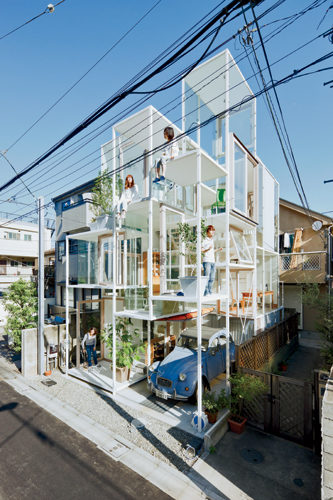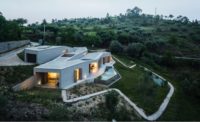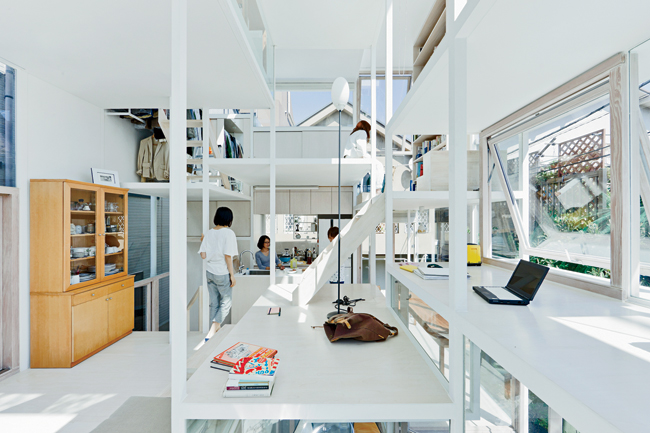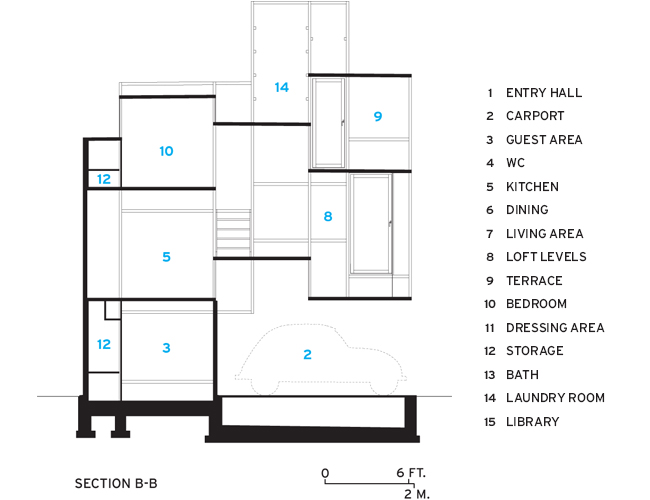House NA
Open House: A clear breach of form within a discreet city, this simple glass house raises the bar on transparent living for a working couple—and their neighbors.


















Architects & Firms
Tokyo
There's no running around naked in Sosuke Fujimoto's House NA. The 3-D matrix of tiny rooms and exterior terraces—all located on different floor levels—is encased almost entirely with see-through glass. Supported by a bare, white structural frame, the transparent walls reveal the interior contents to all who pass by. Even in Japan, where proximate neighbors and thin walls often compromise privacy, an unclothed house is a daring solution.
Yet House NA is not simply a bold, exhibitionist gesture. It is Fujimoto's carefully considered response to the building's surrounding conditions. Designed for a working couple in their forties, the home is located in a quiet Tokyo neighborhood on a 592-square-foot plot that opens onto a narrow street and is hemmed in by adjacent houses just about everywhere else. It does not turn its back on the city with solid walls, a typical strategy for Japan's cramped urban areas. Instead, the house engages the environment with transparency. Just inches away, a neighbor's concrete-block wall doubles as House NA's wallpaper, while a borrowed view toward the roof garden next door enhances the interior.
Inside, there aren't many walls, either. “In a sense, it is like a one-room house,” explains Fujimoto. This vertical “room” is actually 21 individual floor plates that delineate functional areas. Ranging in size from 21 to 81 square feet, the various levels are linked by an assortment of stairs and ladders in addition to short runs of fixed and movable wooden steps.
At grade, the house begins with a covered carport and entrance. The foyer leads down to the guest quarters and up to the kitchen. Abutting a slotlike dining space, the kitchen segues into the living area, a large platform that expands into a series of small, raised lofts that double as seating or work surfaces. Overhead, the sleeping area adjoins the library, followed by a sunroom and multiple tiny terraces. Higher still, a dressing area leads up to the bathroom, which crowns the house.
While the absence of walls, both inside and out, posed a number of practical challenges, the unimpeded flow from one level to another does make the interior feel spacious. Fujimoto installed in-floor heating within some of the horizontal platforms and subtly embedded electrical outlets in the main areas. He concentrated the HVAC and plumbing equipment, storage, and lateral bracing in the thick, north-facing wall at the rear of the house. Then he tucked additional lateral bracing in a full-height bookshelf and lightweight concrete panels inserted into the side elevations.
According to consulting engineer Jun Sato, “In our first meeting the shape of the building was almost fixed, but there was no clear structural direction.” Sato proposed a slender, steel frame system to complement the house's cellular composition and floating floor plates.
Elegant in its simplicity, the structure consists of 1-inch-thick, corrugated-steel deck plates plus solid 1.4-by-2.4-inch rectangular beams and 2-inch-square columns—all assembled on-site with welded joints exclusively. The solid sections of these components required careful temperature control during welding to avoid steel shrinkage. Below grade, the columns are embedded in the concrete foundations anchored to steel piles.
Because of the delicacy of Fujimoto's architecture, Sato went to great lengths to minimize the dimensions of the structural components. While the placement of the individual floors determined the columns' gridlike configuration, the slabs' short spans enabled the design team to reduce the column size and deck thickness. Cross bracing—0.63-inch-diameter round pipes where exposed and flat bars where concealed—not only counter earthquake and lateral forces, they also enabled Sato to reduce the dimensions of the square pillars.
Integral to the architecture, white-tinted birch flooring and stairs blend with the structure and serve as a visual transition to the chunky wood sashes and frames that outline the operable windows. The fenestration, strategically positioned to maximize the flow of fresh air, is the house's only source of ventilation and cooling.
Living in a home as exposed as House NA is not for everyone, not even the architect. “The composition of space—a group of small floors at different levels—is fine for me, but this house would honestly be too open for my personal residence,” admits Fujimoto. His clients even added some curtains and blinds. It seems, for them, privacy is more than a state of mind.
Naomi Pollock is RECORD's Tokyo-based correspondent.
Completion Date: October 2010
Size: 914 square feet
Total construction cost: Withheld per client’s request
Architect:
Sou Fujimoto Architects
Ichikawa Seihon building 6F
10-3, Higashienoki-cho,
Shinjuku-ku,Tokyo 162-0807, Japan
Tel: +81(0)3-3513-5401
Fax:+81(0)3-3513-5402
PeopleOwner: Individual Architect Personnel in architect's firm who should receive special credit: Engineer(s): Jun Sato Structural Engineering General contractor: HEISEI construction Photographer(s): CAD system, project management, or other software used: |
ProductsExterior cladding Wood: Birch veneer t=3mm/OSUC Paint/Thin white Curtain wall: Nippon Sheet Glass (10mm float glass with a photocatalytic coating and insulation film) Roofing Windows Metal frame: (exterior) Aluminum Glazing Insulated-panel or plastic glazing: Polystyrene foam/Insulation paint Doors Wood doors: Basswood Plywood Sliding doors: Aluminum Interior finishes Cabinetwork and custom woodwork: Basswood plywood/ Beech plywood/ Pine glulam Wall coverings: Birch veneer t=3mm/ OSUC paint/ Thin white Special surfacing: Float glass/ Insulation film/ Photocatalyst coating |














